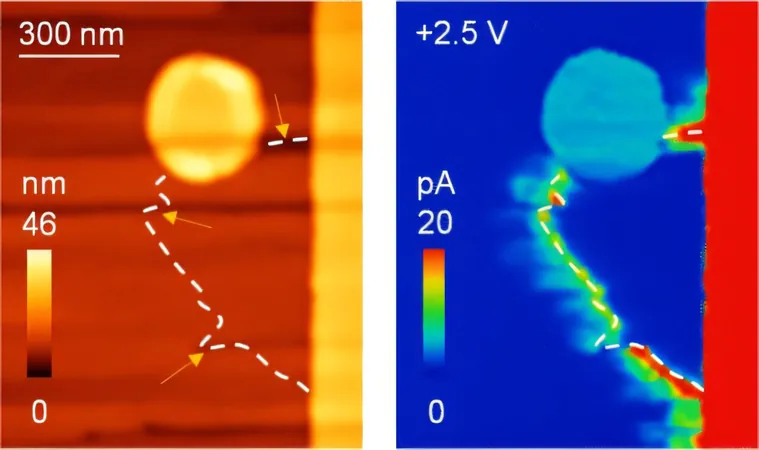
Revolutionary Brain-Inspired Nanotech Set to Transform Electronics Forever!
2025-01-07
Author: Li
Introduction
Imagine a future where your gadgets aren’t just smart but genuinely intelligent—processing information with lightning speed and efficiency, much like the human brain. A groundbreaking advancement from researchers at Flinders University and UNSW Sydney is pushing the boundaries of what’s possible in technology, bringing us closer to this remarkable vision.
The Core Innovation
At the core of this innovation lies the unique capability to electrically 'twist' a nanoscale ferroelectric domain wall—a minuscule yet powerful component that could change everything. These domain walls, measuring a mere 1-10 nanometers, are tiny boundaries within special insulating materials known as ferroelectrics. They separate regions that hold different charge orientations and, intriguingly, despite their minute size and insulating nature, these boundaries can regulate electron flow, effectively allowing them to store and process information similar to brain function.
Expert Insights
Dr. Pankaj Sharma, a senior lecturer in physics at Flinders University, highlights the significance of this research: "Devices that mimic human brain capabilities enable us to process vast streams of information efficiently, using far less energy than traditional computers. This is especially beneficial for tasks like image and voice recognition."
Future Implications
But what does this mean for the future of technology? This innovative design showcases how these ferroelectric domain walls could lead to a brand-new wave of adaptable memory devices that promise not just faster but also greener electronics. Dr. Sharma adds, "Our findings reaffirm the potential of ferroelectric domain walls in neuromorphic and in-memory computing applications, paving the way for integrated devices that offer unprecedented capabilities."
Technical Mechanics
The research illustrates how manipulating a single ferroelectric domain wall emulates the behavior of memristors—devices that can remember past electrical activity, much like synapses in the brain. By applying electric fields, scientists can bend and warp the wall, altering its electronic properties and expanding its ability to store and process data. This sophisticated control makes these systems highly versatile and robust.
Research Collaboration
Co-author Professor Jan Seidel from UNSW emphasizes, "The innovation lies in understanding how the wall's surface pinning interacts with its ability to twist or warp. This creates a variety of electronic states that allow for multi-level data storage, enhancing stability and reliability.”
Microscopy and Modeling Advances
Utilizing advanced microscopy techniques and theoretical modeling, this study unveils the intricate physics at play behind these electronic transitions, making the technology not just a theoretical concept but a practical possibility.
Comments on Future Developments
Moreover, Professor Valanoor Nagarajan from UNSW notes, "The potential of these energy-efficient domain wall devices is enormous, especially for neuromorphic computing. They could redefine artificial intelligence and data processing, steering us towards a future where machines can think and learn more like us."
Conclusion
With the broad scope of applications ranging from smartphones to intelligent wearables, this brain-inspired nanotechnology could signal a new era in electronics—one that embraces efficiency, sustainability, and a touch of ingenuity. Hold onto your gadgets; the future is nearly here!
 Brasil (PT)
Brasil (PT)
 Canada (EN)
Canada (EN)
 Chile (ES)
Chile (ES)
 Česko (CS)
Česko (CS)
 대한민국 (KO)
대한민국 (KO)
 España (ES)
España (ES)
 France (FR)
France (FR)
 Hong Kong (EN)
Hong Kong (EN)
 Italia (IT)
Italia (IT)
 日本 (JA)
日本 (JA)
 Magyarország (HU)
Magyarország (HU)
 Norge (NO)
Norge (NO)
 Polska (PL)
Polska (PL)
 Schweiz (DE)
Schweiz (DE)
 Singapore (EN)
Singapore (EN)
 Sverige (SV)
Sverige (SV)
 Suomi (FI)
Suomi (FI)
 Türkiye (TR)
Türkiye (TR)
 الإمارات العربية المتحدة (AR)
الإمارات العربية المتحدة (AR)